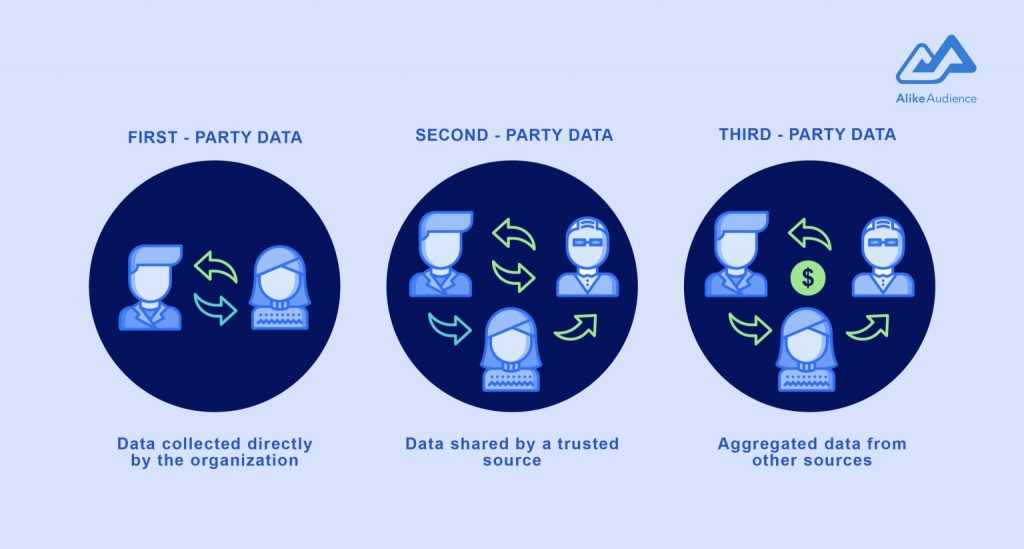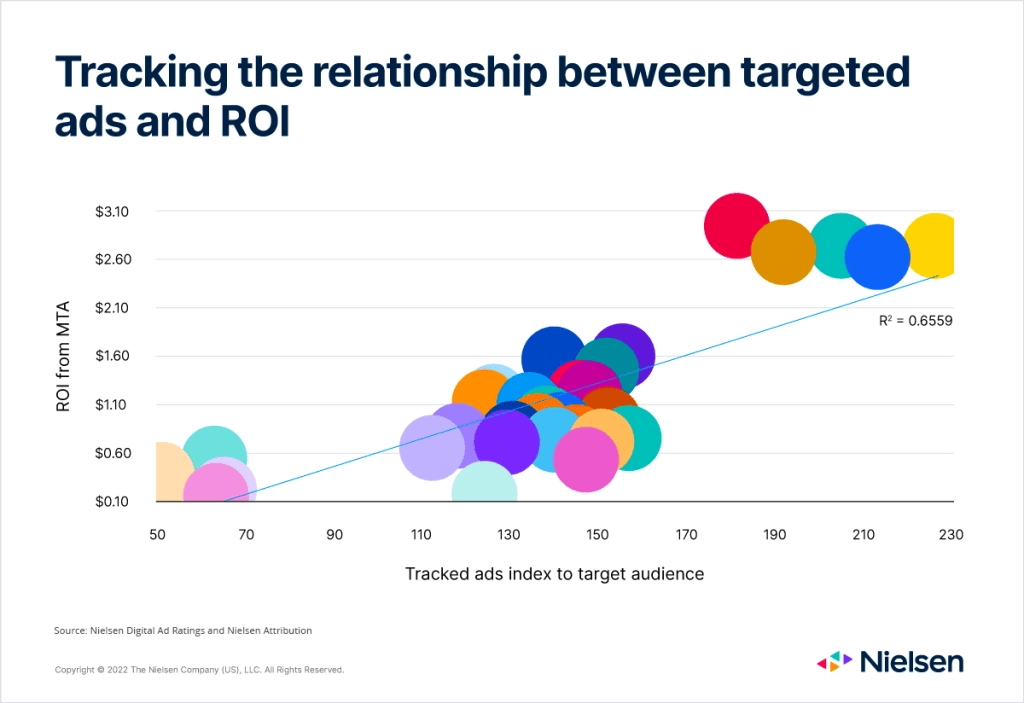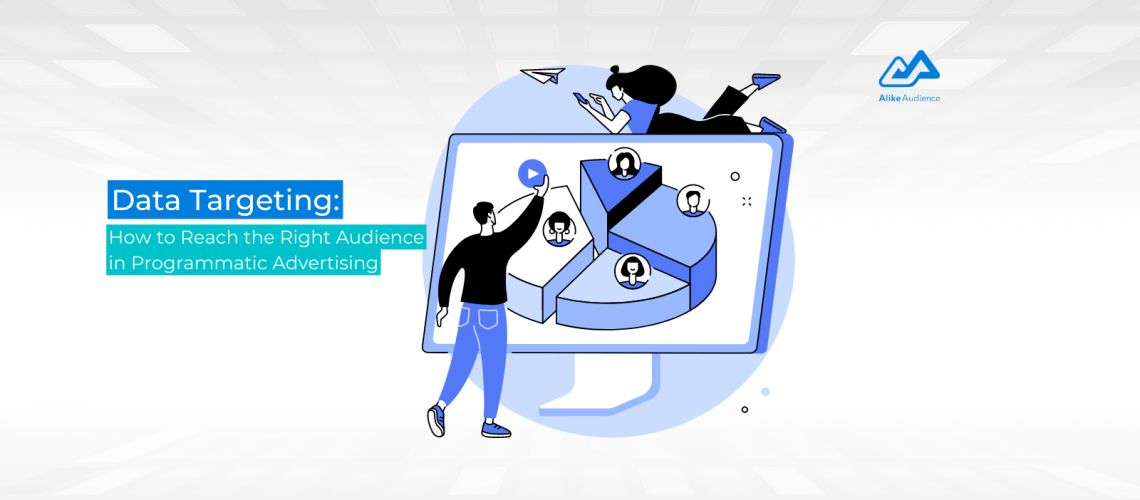The most effective ads are those displayed to interested and ready-to-buy audiences. That is why programmatic ad campaigns succeed with accurate audience data targeting.
A recent report supports this stating “when there’s alignment between a given ad and the content it appears in, search intent rises by 7 percent while brand relevancy rises 6 percent.”
This demonstrates the crucial role high-quality audience data plays in personalizing ad experiences, therefore maximizing its effectiveness.
In this article, we will define data targeting, explore several types of data used for audience targeting, including their sources and examples, and provide successful strategies for utilizing audience data in well-targeted programmatic advertising campaigns.
Data targeting in programmatic advertising is a strategy where marketers use data to target specific audience segments with personalized ads. The targeting can be based on demographics, location, company industry, technology stack, and purchase intent.
Note that data targeting cannot be used interchangeably with “audience targeting” because while the latter groups audiences based on specific criteria such as online behavior and interests, data targeting uses audience data to target them with relevant content and ads.
However, in data-driven marketing, data targeting and audience targeting have similar benefits — the most noteworthy being matching ads with audiences interested in them for high-ROI advertising. Ad placement and audience targeting, according to HubSpot, are the top ways advertisers drive more demand.
To fully understand data targeting, let’s explore the types and source
Types and Sources of Data for Audience Targeting

Marketers use three main types of data for audience targeting in programmatic advertising:
1. First-party data targeting: This is targeting an audience based on data you have collected from web visitors interacting with your website and brand. This data is collected through their interactions with your various sales and marketing touchpoints; hence, it’s also called customer data.
First-party data helps you create ideal customer profiles based on accurate information you can validate at the source. Some common sources of first-party data include website analytics tools and customer relationship management (CRM) systems.
2. Second-party data targeting: This involves using data that is shared between two different companies, typically for the purpose of targeting common audiences with personalized ads.
This data is often collected by one company and then shared with another company interested in targeting a similar audience. However, to access and target the audience of another business, you would need a direct agreement with them, which might be challenging if your audience includes people to whom the GDPR applies.
Some examples of second-party data sources include partnerships between brands, data-sharing agreements between companies, and collaborations between industry organizations.
3. Third-party data targeting: In this type of data targeting, you use data collected by third-party companies and sold to advertisers. Targeting new audiences with Facebook or LinkedIn ads is an example of third-party data targeting.
Third-party data sources include data management platforms, marketing automation tools, and consumer research firms.
While these types of data can be beneficial for audience targeting, it is important to know the potential privacy concerns that can arise when using this data. Advertisers must comply with all relevant laws and regulations when collecting and using data for audience targeting purposes.
It is also important to note that “data targeting” does not refer to the same thing as “data points” in audience data. Data points are individual pieces of information used to understand and segment audiences, such as age, gender, location, and interests.
These data points form the foundation for the various elements of data targeting, which include the strategies below.
Read more: The Bad Rap of Third-Party Data: Do We Still Need It in 2023?
Examples of Audience Targeting Strategies

How do marketers actually use first-, second-, or third party data to segment their audiences and find out which groups of audiences to target? There are three main ways:
1. Demographic Audience Targeting
Comprehending and dividing a target market into categories based on shared demographic traits is known as demographic audience targeting.
For example, many high-end lifestyle magazines that target people with high incomes feature ads for luxury clothes businesses or exotic travel and tours. These companies rarely employ widely viewed, traditional marketing techniques, such as TV commercials.
As advertisers concentrate their campaign efforts on their target market, this not only strengthens the exclusivity of their brand but enables them to achieve impressive ROI by focusing their ad spend where it’s most productive.
This is only possible with audience data that puts a spotlight on the ideal customers and where to place those ads.
2. Psychographic Audience Targeting
Psychographic audience targeting places relevant ads in front of audiences segmented by their broader perspectives, interests, and mindsets. It’s also known as attitudinal audience targeting.
For instance, audiences can be sorted by interest in specific types of music or movie genres, lifestyle choices, values, or morals, personality traits, and support for pro-environment movements.
This gives depth to your understanding of your target audience and makes your ad placements even more relevant and effective.
3. Behavioral Audience Targeting
Here, you use data collected to analyze audience behaviors and interactions with businesses and brands to build an understanding of how they act.
For example, Starbucks uses behavioral segmentation to target its regular morning customers and offers them a reward to encourage a return for another purchase later in the day.
They use push notifications from their mobile app to advertise happy hour events as these frequent customers are more likely to grab an afternoon coffee occasionally.
4 Audience Data Targeting Strategies for Effective Programmatic Ad Campaigns
But just segmenting audiences is not enough. These are the three extra steps you need to take to target the most accurate audiences as possible.

1. Build Lookalike Audiences
Lookalike audiences are created (most times algorithmically) from a “seed audience” of existing or likely customers. This enables businesses to significantly increase the reach of their advertisements using data without compromising precise targeting.
Lookalike audiences enable advertisers to connect with prospective customers who may exhibit similar traits and interests, improving ad performance.
For example, in a $1000 Facebook ad experiment between lookalikes and interests, the lookalike audience won with a 13% lower CPA and a better clickthrough rate and cost per click.
In the lookalike modeling process, a small seed audience is frequently combined with a wider data universe, known as a reference collection. Reference sets are offered by a data/service provider or come standard in a social media platform, a demand-side platform, or a data management platform (DMP).

2. Create Custom Audience Segments
When you group audiences according to a unique criterion, you have created a custom audience segment. The criteria are a unique combination of requirements in age, interests, gender, location, marital status, behavior, and purchase intent. This creates a feeling of personalized ad experiences for the audience.
While there are numerous methods for audience segmentation, identifying the right audience is always the main objective. When the target market is identified, you can then blend user attributes.
To build a segment that meets programmatic advertising needs, machine learning is used to search databases with millions of user profiles and choose the desired qualities.
For example, a clothing retailer might create a custom audience segment of female shoppers between 18 and 34 who have previously made a purchase online. This segment could be targeted with personalized advertisements or custom marketing messages to encourage repeat purchases.
3. Combine Contextual Targeting and Audience Targeting
Contextual targeting is a technique used in marketing where ads are shown on websites with content related to the advertisement’s subject matter. This means that the products or services advertised will be relevant to the content the target audience is already engaged with.
Audience targeting, on the other hand, uses various data signals to target specific audiences, including contextual, behavioral, demographic, psychographic, and others. It is both a high-level strategy incorporating user-profiles and an all-encompassing method of ad serving.
Statistics from a variety of studies, including an audience targeting report released by Nielsen in 2022, have revealed the significance of the “new method” to audience targeting in modern digital advertising.

This chart from the research illustrates how campaigns that display more ads to a clearly defined target group can increase return on ad spend by up to 10 times.
To attain such ad effectiveness, an approach called “multi-touch attribution” is suggested as one efficient way to combine contextual, behavioral, and audience targeting capabilities.
In the associated article, Nielsen also points out that while 36% of marketers find it difficult to put the data to practical use, 69% of marketers globally believe that first-party data is essential for accomplishing effective audience targeting.
While most marketers still view behavioral targeting using first-party data as a novel and highly experimental endeavor, contextual targeting’s simplicity of use shines in solving the first-party data problem.
Publishers can compile useful first-party contextual data about their user base using contextual management tools, which provide an out-of-the-box solution for building and maintaining contextual audience segments.
Additionally, by combining self-serve advertising platforms, a growingly popular technique to reduce friction from media sales, publishers can exhibit the contextual audience segments they have developed directly to their advertising partners.

4. Implement a Mobile-First Ad Strategy
There are several trends in mobile device usage that are providing an increasingly rich source of data for more accurate audience targeting.
One trend is the growing use of smartphones, which are often connected to the internet and equipped with sensors that gather data about their users’ locations, behaviors, and preferences. Another trend is the increasing use of mobile apps, which can collect data about how people use their devices and their interests.
Additionally, the rise of the Internet of things (IoT) is leading to the proliferation of connected devices, such as smartwatches and home appliances, which can also generate data used for audience targeting. These trends contribute to the growing volume of data available to effectively target audiences.
The automated purchasing and selling of ad spaces, specifically for mobile display adverts, is called mobile programmatic advertising. These mobile ads may be banner ads, native ads, video ads, or any other type of ad that is designed specifically for mobile displays.
Mobile data can be used by advertisers in numerous ways and is ideal for performance-based marketing and branding objectives. Acquiring a thorough understanding of consumers and their path to purchase aids brands in improving audience insights. Furthermore, several merchants successfully leverage location-based information to enhance attribution analysis of marketing campaign efficacy.
Digital marketers can be assured that mobile-enabled data will provide them with important user insights necessary for enhancing their overall advertising campaigns, website traffic, and user engagement.
These consist of all-encompassing, data-driven approaches to better comprehend the interests of a particular target market, particularly their demographic and behavioral characteristics.
For example, a company might use a programmatic advertising platform to target users who have previously shown an interest in their products with personalized ads when they visit mobile websites or apps. The platform would use data about the user’s interests and behaviors to tailor the ad to make it as relevant and engaging as possible.
Read more: How Advertisers Win with a Mobile-First Strategy: Guide to Mobile Programmatic Advertising
Privacy Compliance in Audience Data Targeting

The climate surrounding data privacy and protection has changed substantially in recent years. Although some customers and thought leaders have debated the value of data privacy for a decade or more, the European Union proposed a set of data privacy legislation known as GDPR in 2016.
When it was enacted in 2018, businesses had to allow EU users to consent to acquiring their personal data. This sparked the emergence of parallel laws throughout the world. The California Consumer Privacy Act (CCPA), which outlined new privacy rights for California customers, was passed later that year.
For many years, marketers have become accustomed to using massive amounts of data to develop marketing campaigns and target the right audience. This data flood is beginning to slow down into a modest stream as people become increasingly concerned about privacy.
Many marketers worry that it’s only a matter of time before that torrent of data turns into an inconsistent trickle, even if most of them can still carry on business as usual with less data.
This is affecting marketing and programmatic advertising teams. However, using non-personally identifiable information (non-PII) that is CCPA and GDPR-compliant to reach target audiences at scale is the most effective direction to go, as people who reside in California are protected by the CCPA. The GDPR focuses on data subjects or any EU resident who can be directly or indirectly identified. Both laws apply globally, albeit in slightly different situations.
At AlikeAudience, privacy is our priority. We work only with trusted data partners and consumer-consented data that are fully compliant with GDPR and CCPA regulations.
Ready to leverage data targeting to reach the right audience for your ad campaigns? Book a data strategy session with us now.



